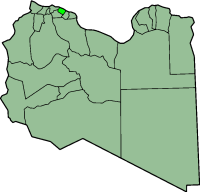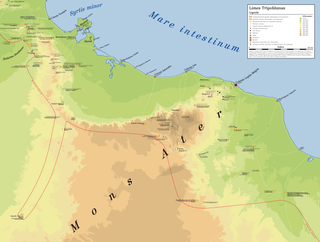
Leptis or Lepcis Magna, also known by other names in antiquity, was a prominent city of the Carthaginian Empire and Roman Libya at the mouth of the Wadi Lebda in the Mediterranean.

Oea was an ancient city in present-day Tripoli, Libya. It was founded by the Phoenicians in the 7th century BC and later became a Roman–Berber colony. As part of the Roman Africa Nova province, Oea and surrounding Tripolitania were prosperous. It reached its height in the 2nd and 3rd centuries AD, when the city experienced a golden age under the Severan dynasty in nearby Leptis Magna. The city was conquered by the Rashidun Caliphate with the spread of Islam in the 7th century and came to be known as Tripoli during the 9th century.

Al Khums or Khoms District was a district of Libya from 1983 to 1995. It was in the northwest area of Libya, bordering the Mediterranean Sea. Its capital was Khoms.

Sabratha, in the Zawiya District of Libya, was the westernmost of the ancient "three cities" of Roman Tripolis, alongside Oea and Leptis Magna. From 2001 to 2007 it was the capital of the former Sabratha wa Sorman District. It lies on the Mediterranean coast about 70 km (43 mi) west of modern Tripoli. The extant archaeological site was inscribed as a UNESCO World Heritage Site in 1982.

Italo Gismondi was an Italian archaeologist. He is most famed for Il Plastico, a massive scale model of imperial Rome under Constantine the Great.

Tarhuna wa Msalata was a district of Libya until 2007. Between 1988 and 1995 there existed the Tarhuna District, which became Tarhuna wa Msalata between 2001 and 2007. It consisted of twenty-six Basic People's Congresses, similar to townships, and its capital was Tarhuna. In the 2007 administrative reorganization the territory formerly in Tarhuna wa Msalata was transferred to Murqub District.

The Capitoline Venus is a type of statue of Venus, specifically one of several Venus Pudica types, of which several examples exist. The type ultimately derives from the Aphrodite of Cnidus. The Capitoline Venus and her variants are recognisable from the position of the arms—standing after a bath, Venus begins to cover her breasts with her right hand, and her groin with her left hand.

The Limes Tripolitanus was a frontier zone of defence of the Roman Empire, built in the south of what is now Tunisia and the northwest of Libya. It was primarily intended as a protection for the tripolitanian cities of Leptis Magna, Sabratha and Oea in Roman Libya.
Sidi Abd As-Salam Al-Asmar was a renowned religious Libyan Muslim saint who lived and died during the 15th century. He is called al-Asmar because he stayed up most of the night in prayer.
Publius Septimius Geta was the father of the emperor Lucius Septimius Severus, father-in-law of the Roman empress Julia Domna and the paternal grandfather of the Roman emperors Caracalla and Geta. Besides mentions in the Historia Augusta, Geta is known from several inscriptions, two of which were found in Leptis Magna, Africa.

Tourism in Libya is an industry heavily hit by the Libyan Civil War. Before the war tourism was developing, with 149,000 tourists visiting Libya in 2004, rising to 180,000 in 2007, although this still only contributed less than 1% of the country's GDP. There were 1,000,000 day visitors in the same year. The country is best known for its ancient Greek and Roman ruins and Sahara desert landscapes.
Hasdrubal I was a Magonid king of Ancient Carthage, a kingdom with its capital, Carthage, located in present-day Tunisia, from 530 to 510 BC.

Al-Khums or Khoms is a city, port and the de jure capital of the Murqub District on the Mediterranean coast of Libya with an estimated population of around 202,000. The population at the 1984 census was 38,174. Between 1983 and 1995 it was the administrative center of al-Khums District.

Gerisa, also called Ghirza, was an ancient city of Roman Libya near the Limes Tripolitanus. It was a small village of 300 inhabitants on the pre-desert zone of Tripolitania.

The area of North Africa which has been known as Libya since 1911 was under Roman domination between 146 BC and 672 AD. The Latin name Libya at the time referred to the continent of Africa in general. What is now coastal Libya was known as Tripolitania and Pentapolis, divided between the Africa province in the west, and Crete and Cyrenaica in the east. In 296 AD, the Emperor Diocletian separated the administration of Crete from Cyrenaica and in the latter formed the new provinces of "Upper Libya" and "Lower Libya", using the term Libya as a political state for the first time in history.

The Martyrs' Square ; known as Green Square under the Gaddafi government; Independence Square during the monarchy; and originally known as Piazza Italia is a downtown landmark at the bay in the city of Tripoli, Libya. The main commercial center of the city surrounds the square. The Square is also a main tourist attraction in Tripoli. It has a large legendary fountain done by an Italian architect at the centre of the square. The square is the meeting point of many different avenues. Omar Mukhtar Avenue is one of the longest in North Africa, it was built by Italians in the colonial time, and Libyans during the era of King Idris I. Independence Street branches from the square too, and it leads to the Palace of King Idris I. 24 December Avenue is also an Italian built avenue. Mizran Street is the last street that branches from the Martyrs' Square.

The Arch of Septimius Severus is a triumphal arch in the ruined Roman city of Leptis Magna, in present-day Libya. It was commissioned by the Roman Emperor Septimius Severus, who was born in the city. The arch was in ruins but was pieced back together by archaeologists after its discovery in 1928.
Theresa Howard Carter was an archaeologist, educator, and scholar.

Architecture in Libya spans thousands of years and includes ancient Roman sites, Islamic architecture, and modern architecture.















